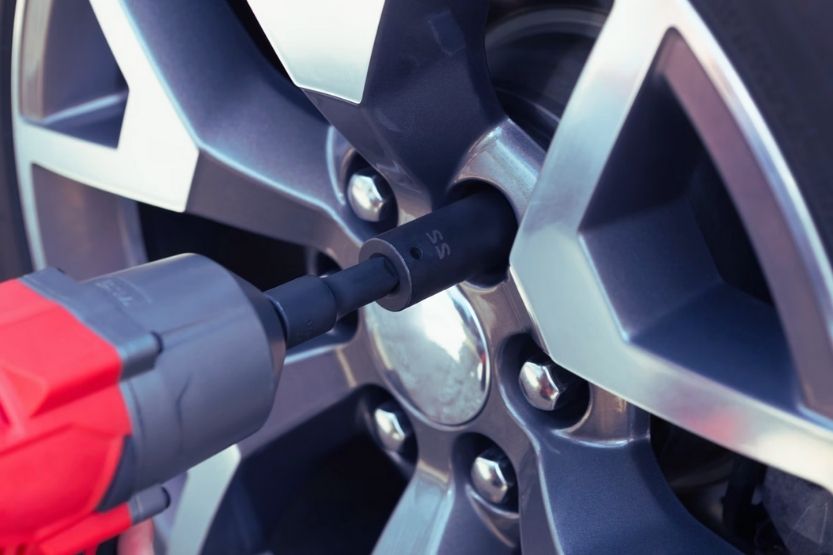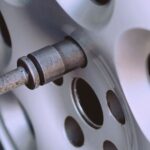Every so often, we need to give our cars a maintenance check-up to make sure that they are running in tip-top condition. Tire rotation is one of these vital maintenance services that your vehicle should not do without. How much is the average cost of a tire rotation?
Tire rotation is an essential maintenance task that serves to extend the lifespan of your tires. It’s not very expensive, with an average tire rotation cost of $35 to $45 if done at a service shop. But if you decide to rotate your tires by yourself, it could cost you anywhere from a few bucks – to nothing at all!
Read on to learn more about the cost of tire rotation.
Cost of Tire Rotation [Average Rotation Cost]

Tire rotation is a vital maintenance task as it serves to extend the lifespan of your tires. It’s not very costly, with an average tire rotation cost of $35 to $45 if done at a service shop. But if you decide to rotate your tires by yourself, it could cost you less – or even nothing at all.
$10 to $20 per Wheel
On average, tire rotation at a service shop will cost you about $35 to $45. Sometimes, it would cost you between $40 to $80. This would be around $10 to $20 per wheel. Either way, it would only cost you about as much as getting your oil changed.
Speaking of an oil change, most people don’t take their car in just for a tire rotation. They would usually have them in conjunction with other maintenance services. These include changing oil or filters.
So, in those instances, you would be spending quite a bit. If a tire rotation is all that you came for, then you get a lot more than your money’s worth.
Other Tire Services
Just the same, should you happen to have a few more bucks you could spare, you may want to avail yourself of other tire services, including:
- Wheel alignment,
- Wheel balancing,
- Tire servicing, and
- Tire replacement.
These services could be helpful to you in the long run.
Walmart vs Cosctco vs DIY Tire Rotation Cost
Walmart
Most Walmart stores offer tire rotation services. They offer these services for $2.50 per tire. Walmart has professional tire technicians that can efficiently rotate your tires to a different location on the vehicle.
Costco
Costco offers tire rotation services too. They have an installation charge of $18.99 per tire. Their services include the following:
- Mounting
- Balancing
- Rotation
- Flat Repair
- Air Pressure Checks
- New Rubber Valve Stem
- Costco Wholesale’s Road Hazard Warranty
DIY Tire Rotation
The average cost of tire rotation is very affordable. But you may opt to try rotating your tires by yourself for some reason.
The only expenses you’ll need to make are for the tools you would need for this task.
Materials
Below is a list of these items and how much they roughly cost.
- Latex/nitrile gloves – $10
- Sockets – $30
- Breaker bar – $35
- 4 axle stands – $100
- Torque wrench – $100
- Trolley jack – $200
From the prices listed above, you would be spending about $475 to purchase the needed items. It’s a lot more than a single professional tire rotation cost. But the chances are that you already have most of these tools in your garage.
And even so, once you have the equipment, you’ll be able to use them over and over again. Then you can perform regular tire rotations for practically no charge.
Again, how much does a tire rotation cost? The average tire rotation costs $35 to $45. However, this cost depends on some factors, including labor and the local auto shop’s rate. So, ensure to set aside a total of $45 to $80 for your car’s tire rotation.
What Is Tire Rotation?

Helps Prolong Tire’s Service Life
For car maintenance, tire rotation isn’t usually high on most people’s priority list. But the truth is that tire care should never be taken for granted. Having your tires rotated helps to prolong their service life. It prevents them from wearing out unevenly by periodically swapping their positions.
Not getting your tires rotated doesn’t do much harm to your car as a whole. But it will take a huge toll on your tires in the long run. As you drive, you subject your tires to different degrees of force by their position in your car.
Some tires would be more beat up than others. This then causes them to give out much sooner. Then you’ll be left with the hassle of constantly replacing worn-out tires one after the other.
Remove Tires from the Original Position
Tire rotation is done by removing your tires from where they were initially positioned in your car—then switching them around to a different position.
For instance, you move the front tires to the car’s back and vice versa. This way, one set of tires won’t wear out faster than the other. Each tire takes turns experiencing the same amount of stress that the rest of the tires have. The wear and tear would be equally distributed among all your tires. This maximizes their performance and extends their life.
Advantages of Tire Rotation
Tire rotation has many advantages. These include the following:
- Longer-lasting Tires
- Safety
- Handling
- Fuel Efficiency
Let’s briefly discuss them.
1. Longer-lasting Tires
Regular tire rotation enables your tires to last for a longer period. Maybe, the only drawback to this is when all four tires eventually wear out. It may cost you quite a lot to have them all changed simultaneously.
2. Safety
Many car crashes occur due to underinflated tires and worn treads. The resident technician will examine your inflation pressure and tread depth when you’re getting a tire rotation. They will also inspect your tires thoroughly for any potential problems.
With proper tire maintenance, you reduce the likelihood of encountering accidents on the road. You are assured of safe and smooth driving.
3. Handling
Unevenly worn-out tires tend to run into trouble with sudden turns and stops. But getting your tires rotated gives them better traction and more balanced handling. This is particularly helpful when you’re driving on slick roads under cold-weather conditions.
4. Fuel Efficiency
Uneven tire wear usually leads to lower vehicle performance. This, in turn, causes fuel efficiency to decrease by up to 3%. Just as tire rotation improves tire efficiency, so too does it increase that of fuel. It will save you a lot on refilling expenses.
How Often Should Tires Be Rotated?
Manufacturers Recommend Tire Rotation Every 6,000 to 8,000 Miles
There are varying opinions on how often you should get your tires rotated. Most mechanics would suggest that you get tire rotation around once every six months. This equates to 5,000 to 7,000 miles. On the other hand, most tire manufacturers and automakers would recommend that you rotate your tires every 6,000 to 8,000 miles.
Heavier Vehicles Need Tire Rotations Often
At any rate, how often you rotate your tires usually depends on what kind of vehicle you drive. Heavier vehicles, in particular, tend to need to have tire rotations more often. This is because of how much wear and tear their tires go through. To be sure, refer to your owner’s manual to determine if your vehicle is due for a tire rotation.
Tire Rotation Patterns

Before you start to rotate your tires, you have to be aware that certain vehicles have a specific rotation pattern based on certain factors. These include their drivetrain type, wheel size, or even the number of tires.
You will need to identify the proper rotation pattern for your car before you start switching your tires around. The more common patterns involve the following:
- Front Wheel Drive
- Rear Wheel Drive or Four Wheel Drive
- Rotational Tires
1. Front Wheel Drive
Reposition the rear wheels to the front of the car, but on the opposite side. Place the front wheels in the back position. But make sure to keep the sides the same.
Do this same step on your car’s rear wheels. Then, take the front wheels in the back to the opposite side. By doing so, you’re switching the nearside front tire with the offside rear tires and vice versa.
2. Rear Wheel Drive or Four-Wheel Drive
Take the front wheels to the rear of the car, but switch the sides. Position the rear tires to the front, but keep them on the same sides.
The same as the second step for front-wheel drive, repeat the first step on the rear wheels. But this time, take the front wheels in the back to the opposite side. This way, you’re switching the positions of the nearside front tire switches with the offside rear tires and vice versa.
3. Rotational Tires
Some cars have permanently fitted tires that you have to rotate in a specific pattern. These kinds of tires are designated with an arrow on the tire that indicates their direction of rotation.
Swap the tires across the axle. Switch the offside front tire with the nearside front tire and the offside rear tire with the nearside rear tire.
Swap the tires down each side of your car. Switch the offside front tire with the offside rear tire and the nearside front tire with the nearside rear tire.
Safety Tips During Tire Rotation
1. Wear a Pair of Gloves
Before you start rotating tires, make sure that you’re wearing a pair of gloves. Do not put any part of your body under the car.
2. Lift Heavy Objects Properly
Make sure you know how to lift heavy objects. These include tires and wheels. This way, you wouldn’t hurt your back. When you use axle stands instead of a ramp, you’ll spend more time bending over. You might seriously hurt yourself if you stand up the wrong way.
3. Utilize the User’s Manual
Consult the diagram on your owner’s manual. This way, you’ll determine the best and safest places to put the jack, and the axle stands. If you are unable to find it, make a quick Google search for answers.
Check to see if your wheels don’t have a Direct Tire Pressure Monitoring System (TPMS).
4. Use Proper Tools
When you’re done, and the car is back on the ground, use the torque wrench to tighten the wheel.
Step-by-Step Guide on How to Rotate Tires
- Turn Engine Off
- Loosen the Nuts
- Jack Up the Car
- Remove the Remaining Wheel Nuts
- Move the Wheel
- Put the New Wheel in Position
- Lift the Car Off the Axle Stands
- Tighten the Wheel Nuts
1. Turn Engine Off
Before you begin, make sure that the engine has been turned off, and the parking brake is applied. The front wheels should be pointing straight ahead. You should park the car on a flat and level surface.
2. Loosen the Nuts
Using a breaker bar, slightly loosen all the nuts on the wheel. Note that this is easier when the car isn’t suspended in the air. If there is a locking nut on the wheel, remove it entirely.
3. Jack Up the Car
According to the owner’s manual, Jack up the car and put an axle stand in a secure position. Lower the jack gently until the car is resting safely on the axle stand. Then remove the jack altogether.
Do steps 2 and 3 to the three other corners of your car.
4. Remove the Remaining Wheel Nuts
Remove the remaining wheel nuts using a regular ratchet with the proper socket. You may be able to spin the nuts off by hand once they are loosened enough. Be careful when the wheel falls once you remove the last nut.
5. Move the Wheel
Move the wheel over to its new corner.
Do steps 5 and 6 for the other three wheels.
6. Put the New Wheel in Position
Put the new wheel in position. Screw on a couple of wheel nuts with your hand. Once it’s in place, you can put the rest of the wheel nuts. Use a basic ratchet to tighten them if necessary.
Make sure that the wheel nuts are securely tightened and are all correctly placed. Also, make sure that the wheels are well in line with the car.
7. Lift the Car Off the Axle Stands
Lift the car off the axle stands using the jack. Then, lower it back down on its wheels one corner at a time.
8. Tighten the Wheel Nuts
Tighten each wheel nut, as well as the locking wheel nut. Use a torque wrench in the correct setting indicated in the owner’s manual.
Conclusion – Cost of Tire Rotation [Average Rotation Cost]
Tire rotation is a vital maintenance task as it serves to extend the lifespan of your tires. It’s not very costly, with an average tire rotation cost of $35 to $45 if done at a service shop. But if you decide to rotate your tires by yourself, it could cost you less – or even nothing at all.
Tire rotation is an often overlooked but no less crucial automotive maintenance routine. At an average cost of $35 to $45, it is very inexpensive. But if that’s not enough of a bargain, it’s even possible for anyone to do it in their garage at virtually little to no cost. It’s a minimal price to pay for ensuring driving safety.
Related reading:
Walmart Tire Installation Cost [How Much Do They Charge?]
Oil Change at Jiffy Lube Prices
Wheel Bearing Replacement Cost [Front or Rear]
Rod Bearing [What is It, How to Replace It, and Replacement Cost]

![How Much Is a Used Tire? Average Cost of Used Tires [Guide] how much is a used tire](https://roadsumo.com/wp-content/uploads/2022/03/how-much-is-a-used-tire-150x150.jpg)
![How Much Are Car Inspections? [Average Cost] how much are car inspections](https://roadsumo.com/wp-content/uploads/2022/04/how-much-are-car-inspections-150x150.jpg)
![Audi Oil Change Cost [How Much Is It On Average?] audi oil change cost](https://roadsumo.com/wp-content/uploads/2022/04/Audi-oil-change-cost-150x150.jpg)
![Discount Tire Tire Rotation Cost [How Much Is It?] how much does a tire rotation cost at discount tire](https://roadsumo.com/wp-content/uploads/2022/04/how-much-does-a-tire-rotation-cost-at-Discount-Tire-150x150.jpg)
![Walmart Tire Rotation Cost [What Does Walmart Charge?] walmart tire rotation cost](https://roadsumo.com/wp-content/uploads/2021/07/walmart-tire-rotation-cost-150x150.jpg)

![Read more about the article Clearance Tires at Walmart [How Much Are They? Buying Guide]](https://roadsumo.com/wp-content/uploads/2022/04/clearance-tires-at-Walmart-300x200.jpg)

![Read more about the article Who Makes Milestar Tires? [Milestar Tires Review]](https://roadsumo.com/wp-content/uploads/2021/05/who-makes-milestar-tires-300x200.jpeg)